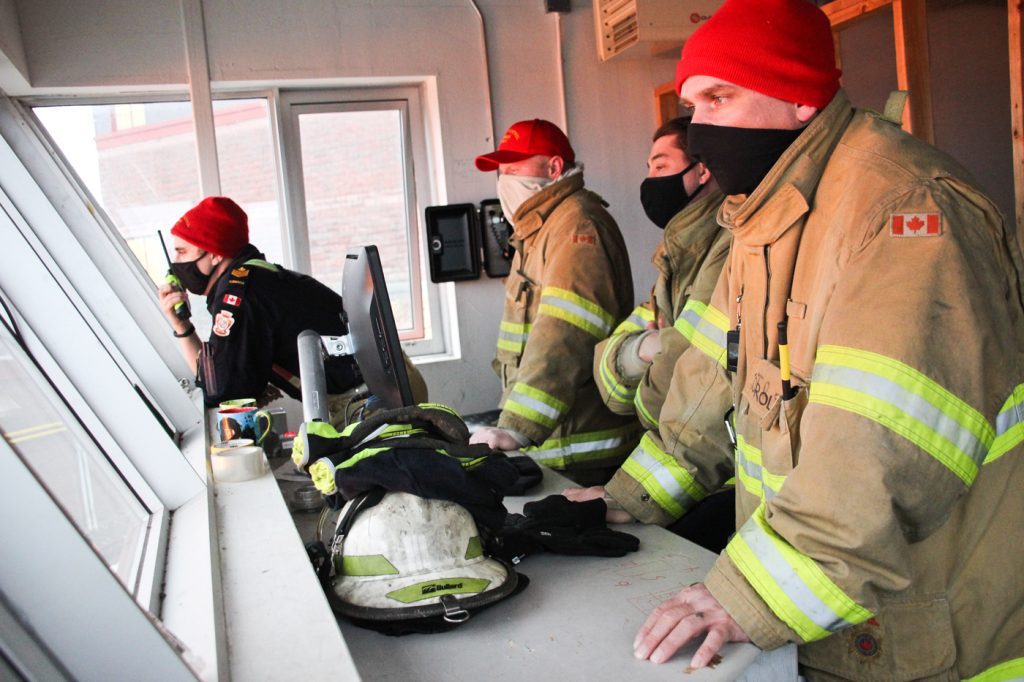
Naval Fleet School (Atlantic) staff look on from the control tower as their colleagues exercise the new helicopter simulator. Photo by Ryan Melanson, Trident Newspaper
Joanie Veitch
Trident Newspaper
––
After months of anticipation, control operators and instructors fired up the new helicopter trainer at Naval Fleet School (Atlantic) Damage Control School in Purcell’s Cove, Halifax, on March 1.
It’s in preparation for an individual helicopter crash rescue training course to go live later this month — the first at the school since November 2019.
The new model is a huge improvement over the previous trainer, says LCdr Andrew Cumming, Commanding Officer at DCTF Kootenay, adding the old trainer was “rusted like an outdoor barbecue” after being heated and cooled during training exercises for nearly 20 years.
Cyclone Trainers
The new trainer simulates the navy’s CF-148 Cyclone, giving it new entry and exit points and different locations for potential fires than the previous helicopter frame, which was installed when DCTF Kootenay was built in 2002 and modelled on the CH-124 Sea King.
Design for the new trainer frame began in 2015 with DCTF managers on both coasts offering feedback on their experience with the original frame.
“The biggest change is the look and feel of the trainer to be a realistic rendition,” says LCdr Cumming. “In any fire, the sooner you can combat it, the more likely it won’t get out of control. You will lower the temperature to increase the survivability of anyone inside. That’s why this training is critical, so that teams advance as quickly and safely as possible to prevent loss of life.”
Systems within the helicopter will extend its service life, such as improved steel and a water system that ensure it doesn’t get as hot as the previous frame, preventing thermal expansion.
The new helicopter trainer was built and installed in February 2020, with the propane, water, air, and control systems put in over the following weeks. The plan was to have the new trainer operational by April 2020, but COVID delayed its completion.
Prior to the shutdown period, managers at DCTF had increased the training schedule, but since November 2019 only the west coast DC Division has run helicopter crash and rescue courses.
On March 1, Damage Control Training Facility Galiano, in Victoria, B.C., went offline until their new helicopter trainer is installed, which is scheduled for some time within the next fiscal year.
How it Works
To simulate a helicopter emergency on board a ship, control operators and instruction staff use propane burners to ignite a fire in any of six locations throughout the helicopter frame. Individual members of the Marine Technician and Boatswain trades, who act as both the ship’s helicopter crash rescue team and the advanced firefighting rapid attack unit, are the first responders if there is a fire on a ship.
Training consists of class time, dry runs, and practice before using the simulated fire, as well as rescue exercises in the helicopter trainer. Up in the control tower, instruction staff work to create as realistic an environment as possible, calling out emergency information over a loudspeaker and watching computer screens to monitor the various fire locations as the flames begin to curl up and around the helicopter frame.
Advances in technology mean new fire supression materials and compounds assist the attack team as they respond to the emergency, LCdr Cumming explains, while improved monitoring systems and other technological innovations improve the overall communication and safety of the simulation.
“The control system for the helicopter is more robust to give operators better safety for students, but the experience is still largely hands on.”
––––











